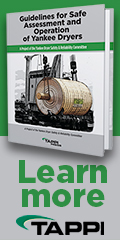
| Archive/Subscribe | TAPPI.org | Advertise | TAPPI Press Catalog | August 2020 |
How to Measure Tissue and Nonwovens Mill Machinery Performance with Real Time Analytics
Writing in the A. Celli newsletter, Tommaso Motta explains that tissue and nonwovens mills rely primarily on the performance of their machinery to ensure the manufacturing of a high-quality product in a reasonable time and at optimal productivity. If this machinery is not running at peak efficiency or if it breaks down, production can slow down or stop altogether. Yet, the equipment and machinery in a mill is subjected to extreme conditions on a daily basis. Machines in the mill are exposed to things like significant temperature variations and ongoing wear and tear that can impact their performance over time. In the past it was difficult, if not impossible, to detect small dips in machinery performance simply because the human eye can’t detect small changes in things like machine vibration or speed. By the time a lag in performance was noticeable, the machine was often already at a point of needing repair or would break down entirely. This is one of the biggest causes of lost productivity in the mill. Fortunately, with today’s technology, it is possible to perform real time analytics, allowing mill staff to know the performance level of their machinery at all times. OEE measures three categories within the mill: equipment availability, equipment performance, and product quality. When it comes to machine performance in the tissue and nonwovens mill, the focus is specifically on equipment availability, the amount of time the machine is actually up and running, and equipment speed. While it is easy to see when a machine is running or not, it isn’t always easy to understand why it has stopped running or to see this downtime coming. When it comes to machine speed, it is not possible to detect small changes in that speed simply by looking at it. In the past, we simply did the best we could and dealt with machine downtime. However, today we have new technology that makes real time analytics possible. Pivotal to the measurement of machine performance in real time is IIoT. IIoT requires the installation of thousands of sensors and cameras along the production line. Every single machine will have dozens or hundreds of sensors that are continuously measuring every single aspect of the machine during operation. These sensors can gather data in a digital format from parts of the machine that mill workers cannot monitor adequately. They can sense changes in the machine’s operation that the human eye can’t even detect, all in real time. The sensors on each machine are part of a company-wide network of sensors and devices that are connected to the cloud. As the data are collected, they are gathered and fed into AI software that can provide real-time analytics. Machine learning allows the machinery to make adjustments in real time and the system can alert staff of anomalous readings and let them know when maintenance is required.
In other words, when something isn’t working at peak efficiency and speed, the system will pick up on that. Maintenance can then be scheduled before those minor anomalies become big enough to cause the machine to slow down or break down entirely. In addition, with such detailed data from every part of every machine, a tissue and nonwovens mill can tweak environmental and machine settings to ensure the highest possible speed a machine can be run at without compromising product quality. This pushes machine performance to its optimal state, and when you can accomplish this, equipment availability and equipment speed scores increase and your overall OEE score goes up. For more information about measuring machine performance in your tissue and nonwovens mill, see Celli’s eBook: The Ultimate Industry 4.0 Guide for the Tissue and Nonwovens Market. |



